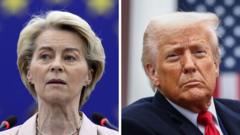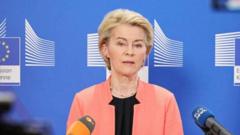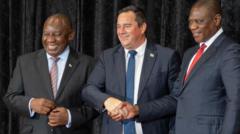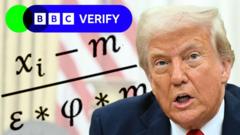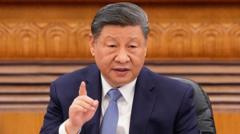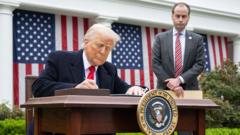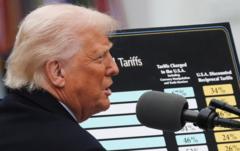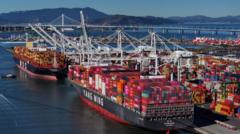A sweeping announcement by Trump escalates trade tensions globally, focusing on tariffs aimed at major international partners.
Trump Implements Broad Tariffs on Global Trade, Excluding North America

Trump Implements Broad Tariffs on Global Trade, Excluding North America
Former President declares economic independence with new trade measures.
In a landmark announcement that has reverberated throughout global markets, former President Donald Trump has rolled out an extensive set of tariffs affecting nearly all U.S. trading partners, with notable exceptions for Canada and Mexico. During an event in the White House Rose Garden, Trump heralded these tariffs as a significant step towards "economic independence," labeling the day as a liberation moment for the U.S. economy.
The newly imposed tariffs are substantial, with China facing a stark 34% tariff, while the European Union will see rates soaring to 20%. Other affected nations include Japan and India with tariffs set at 24% and 26%, respectively. Trump articulated that tariff levels would be determined by the tariffs imposed by the countries in question and various “other forms of cheating” on trade agreements.
In response to the announcement, global markets reacted with great unease, as many governments brace for retaliatory measures that could ignite a tumultuous trade war. Ana Swanson, an international trade expert, underscored the high expectations leading to this announcement, noting the unprecedented nature of the declared tariff levels. Swanson projected that while these measures might incentivize some manufacturing to return to U.S. soil, they will likely result in increased costs for American consumers and create significant challenges for manufacturers reliant on global supply chains.
Debate has emerged among Trump’s advisors regarding the strategic purpose behind these tariffs. Is it primarily to raise revenue, or is the goal centered on reducing barriers to trade? The complexity of this question underscores the economic ramifications of such sweeping policy changes, as differing opinions may inform future adjustments to the U.S.'s trade posture on the global stage. As countries prepare their responses, the world watches closely, aware that the stakes of these decisions are high.
The newly imposed tariffs are substantial, with China facing a stark 34% tariff, while the European Union will see rates soaring to 20%. Other affected nations include Japan and India with tariffs set at 24% and 26%, respectively. Trump articulated that tariff levels would be determined by the tariffs imposed by the countries in question and various “other forms of cheating” on trade agreements.
In response to the announcement, global markets reacted with great unease, as many governments brace for retaliatory measures that could ignite a tumultuous trade war. Ana Swanson, an international trade expert, underscored the high expectations leading to this announcement, noting the unprecedented nature of the declared tariff levels. Swanson projected that while these measures might incentivize some manufacturing to return to U.S. soil, they will likely result in increased costs for American consumers and create significant challenges for manufacturers reliant on global supply chains.
Debate has emerged among Trump’s advisors regarding the strategic purpose behind these tariffs. Is it primarily to raise revenue, or is the goal centered on reducing barriers to trade? The complexity of this question underscores the economic ramifications of such sweeping policy changes, as differing opinions may inform future adjustments to the U.S.'s trade posture on the global stage. As countries prepare their responses, the world watches closely, aware that the stakes of these decisions are high.

